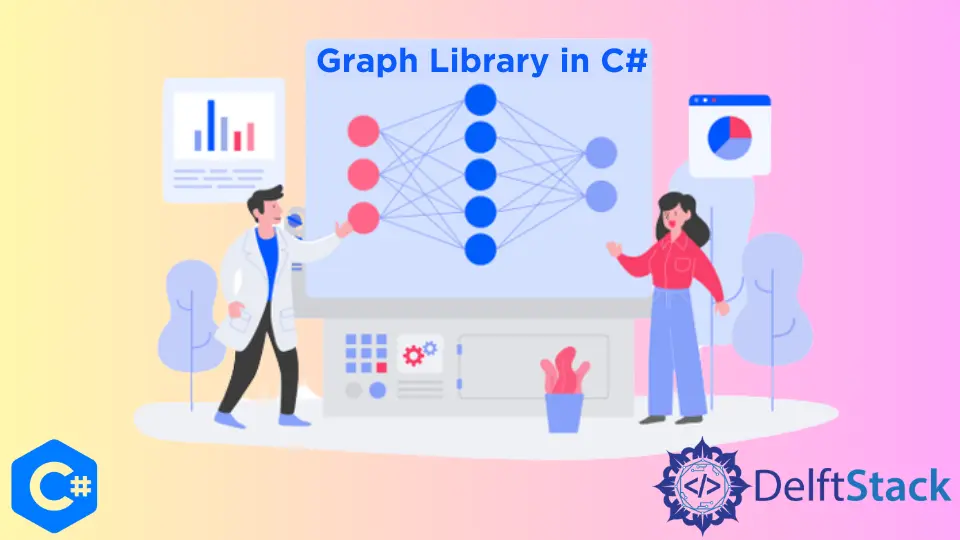Graph Library in C#
-
What Are Graphs in
C# -
What Is the
QuickGraphLibrary inC# -
Deserialization in Graphs in
C# -
Visualization in Graphs in
C#

Say you get a project where you have to work on a network representation of activity dependencies now; what would be the best way to work on this project? The answer to this is a graph.
In such cases, graphs are pretty handy, and they also come with several essential features, making your job much simpler.
What Are Graphs in C#
When you think of a Graph, you probably think of those long vertical bars that represent a numeric value, the kind you used to see in your Math book in school (and maybe still do).
But those aren’t the graphs we’re talking about here; instead, think of a spider web-shaped structure with interconnected parts that represent a whole.
So, let’s delve into what graphs are; usually, a graph has two basic components called Nodes and Edges. Nodes are connected using Edges; the first two Nodes are connected using Edges; then, Nodes can be connected in any number.
Thus, graphs are excellent because of how they are structured when you want to represent a relationship between certain concepts or entities. You have different representation types, algorithms, and data structures to work with.
There isn’t just one type of graph; there are several types of graphs. Types depend on many factors for distinction, the way the edges and nodes function within a graph usually define its type.
For example, one type is called Trees, in which any node can be connected to any other node through one path.
The complexity of many systems is only explained through networks in computer science; hence, Graph Theory is quite useful.
Data Structures in C#
Now that you have defined and identified your project as needing the use of graphs, what you now need to do is choose a data structure for your project.
Because data structures vary depending on your demands, carefully determine your data structures for the most efficient use of graphs. The most important factors for deciding what data structures to use are Memory and Time complexity.
Algorithms in C#
Second, you should include algorithms in your graphs; this will greatly simplify your task. You will probably never need to create some novel algorithms, so remember the usual algorithms you would need and use these in your graphs.
Make yourself comfortable with existing graph libraries. The algorithms you would find in graph libraries are well optimized for time and memory complexities.
Hence, they are your best bet while working with graphs!
Tools Used in Graphs in C#
The following tools will be used in graphs, so familiarize yourself with them well.
- Query & Mutate Using Algorithms
- Serialize / Deserialize
- Visualize
What Is the QuickGraph Library in C#
Created by Jonathan ‘Peli’ de Halleux in 2003, QuickGraph is a .NET library of graphs structures and algorithms for C#. It provides direct/indirect graph data structures.
Its algorithms are depth-first search, breath-first search, A* search, shortest path, k-shortest path, and maximum flow.
Some of the platforms it uses are .NET Standard 1.3+, .NET Core 1.0+, .NET Framework 3.5+ (and others).
QuickGraph is free and open-source software that allows you to construct data structures and algorithms in .NET. It also provides basic serialization/deserialization support and some visualization features, though they are not stable.
QuickGraph’s algorithm library is quite versatile and includes practically anything you would need; it seldom falls short in terms of usability, and the data structures cover a lot of territories and will supply you with what you need in most circumstances.
QuickGraph’s major flaw is its extremely improper documentation; it is scarcely useable and, in some cases, simply incorrect, very simple and lacking in diversity. The API changes while the docs do not adhere to this change in many cases.
This will complicate the process by making you rely on manually checking the library source; hence it is quite frustrating.
The major reason for this is probably the poor maintenance, as the project is still stuck at its version 3.6, and this update came in mid-2011, which is more than a decade ago! Many appreciations to the developer; however, upkeep has to be better.
Nonetheless, despite its downs, it is still the best option out there.
Deserialization in Graphs in C#
Deserialization means changing the format of the graph from one to the other; this is important when you need to export the graph to some other application, updating its context and use according to your needs.
Although QuickGraph gives you the option to serialize to GraphML, you will need to code the serialization on your own for many other formats as there are many formats such as XML and CSV.
GraphDB in Graphs in C#
GraphDB allows you to treat nodes and edges as records or values instead of implicit relationships between tables, as in the case of a relational DB.
This gives you a more natural and more functional graph data processing.
Visualization in Graphs in C#
Visualization is one of the most vital aspects of any process, as giving a graphical representation to a code makes it much more easily understandable and interactive. It makes work much more fluid and quicker.
There are various visualization tools available, one of which is the yEd Graphic Editor. This application is fantastic, and it’s even better because it’s available for free!
Its layout engine, as well as the customization tools that come with it, are fantastic.
Then there’s GraphViz, which is open-source and widely used in academic circles for graph visualization; DOT language scripts are used. It allows you to save schematics as pictures (SVG, for example).
Then there is Microsoft Automatic Graph Layout. This is similar to GraphViz but more basic and compatible with the Windows and .NET ecosystem.
Finally, Gephi is an extremely sophisticated tool that can be used for much more than just visualization. It’s also free and open-source.
It offers extensive plug-in support. It is the most effective visualization tool.
I'm a Flutter application developer with 1 year of professional experience in the field. I've created applications for both, android and iOS using AWS and Firebase, as the backend. I've written articles relating to the theoretical and problem-solving aspects of C, C++, and C#. I'm currently enrolled in an undergraduate program for Information Technology.
LinkedIn